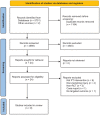Therapeutic Exercises and Modalities in Athletes With Acute Hamstring Injuries: A Systematic Review and Meta-analysis
- PMID: 35996322
- PMCID: PMC10293564
- DOI: 10.1177/19417381221118085
Therapeutic Exercises and Modalities in Athletes With Acute Hamstring Injuries: A Systematic Review and Meta-analysis
Abstract
Context: Hamstring strain is a common injury to the lower limbs. Early intervention in the acute phase aids with restoring hamstring function and prevents secondary related injury.
Objective: To systematically review and summarize the effectiveness of exercise-based interventions combined with physical modalities currently used in athletes with acute hamstring injuries.
Data sources: Five databases (EMBASE, Medline, Cochrane Library, SPORTDiscus, and Web of Science) were searched from inception to July 2021.
Study selection: A total of 4569 studies were screened. Nine randomized controlled trials (RCTs) on the effect of therapeutic exercise programs with and without physical agents in athletes with acute hamstring injuries were identified for meta-analysis.
Study design: Systematic review and meta-analysis.
Level of evidence: Level 1.
Data extraction: The studies were screened, and the evidence was rated using the PEDro scale. Nine RCTs with PEDro scores ranging between 3 and 9 were included and extracted pain intensity, time to return to play (TTRTP), and reinjury rate in the study.
Results: Loading exercises during extensive lengthening were shown to facilitate TTRTP at P < 0.0001 but did not prevent recurrence (P = 0.17), whereas strengthening with trunk stabilization and agility exercise did not reduce the duration of injury recurrence (P = 0.16), but significantly reduced the reinjury rate (P < 0.007) at a 12-month follow-up. The results of the stretching programs and solely physical modalities could not be pooled in the statistical analysis.
Conclusion: The meta-analysis indicated that a loading program helps athletes to return to sports on a timely basis. Although strengthening with trunk stabilization and agility exercise cannot significantly reduce recovery time, the program can prevent reinjury. The clinical effects of stretching programs and pure physical modality interventions could not be concluded in this study due to limited evidence.
Prospero registration: CRD42020183035.
Keywords: acute hamstring injuries; pain; physical modalities; reinjury rate; therapeutic exercise; time to return to play.
Conflict of interest statement
The authors report no potential conflicts of interest in the development and publication of this article.
Figures





References
-
- Aimbire F, Albertine R, de Magalhaes RG, et al.. Effect of LLLT Ga-Al-As (685 nm) on LPS-induced inflammation of the airway and lung in the rat. Lasers Med Sci. 2005;20:11-20. - PubMed
-
- Andrews J, Wilk KH, GL. Physical Rehabilitation of the Injured Athlete. 4th ed.Philadelphia: Saunders; 2012.
-
- Askling CM, Tengvar M, Saartok T, Thorstensson A. Acute first-time hamstring strains during high-speed running: a longitudinal study including clinical and magnetic resonance imaging findings. Am J Sports Med. 2007;35:197-206. - PubMed
-
- Askling CM, Tengvar M, Saartok T, Thorstensson A. Proximal hamstring strains of stretching type in different sports: injury situations, clinical and magnetic resonance imaging characteristics, and return to sport. Am J Sports Med. 2008;36:1799-1804. - PubMed
-
- Askling CM, Tengvar M, Tarassova O, Thorstensson A. Acute hamstring injuries in Swedish elite sprinters and jumpers: a prospective randomised controlled clinical trial comparing two rehabilitation protocols. Br J Sports Med. 2014;48:532-539. - PubMed
Publication types
MeSH terms
LinkOut - more resources
Full Text Sources
Medical
Research Materials

